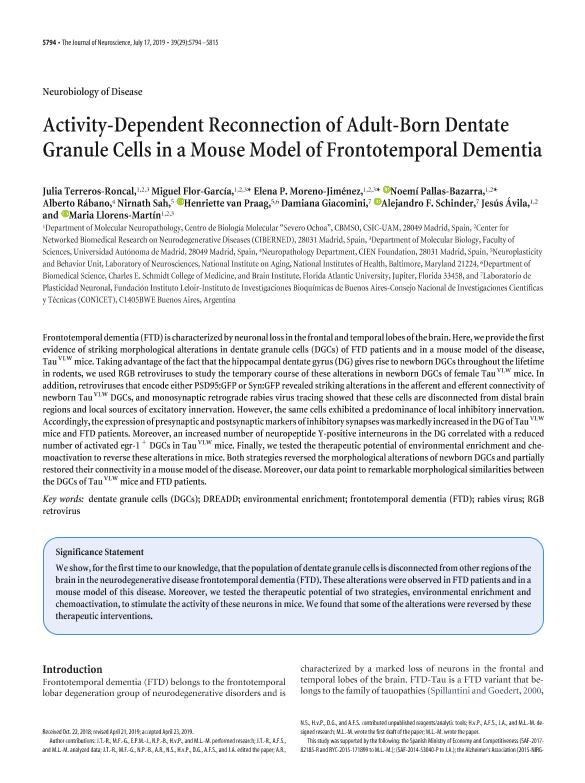Artículo
Activity-Dependent Reconnection of Adult-Born Dentate Granule Cells in a Mouse Model of Frontotemporal Dementia
Terreros Roncal, Julia; Flor García, Miguel; Moreno Jiménez, Elena P.; Pallas Bazarra, Noemí; Rábano, Alberto; Sah, Nirnath; Van Praag, Henriette; Giacomini, Damiana Paula ; Schinder, Alejandro Fabián
; Schinder, Alejandro Fabián ; Ávila, Jesús; Llorens Martín, Maria
; Ávila, Jesús; Llorens Martín, Maria
 ; Schinder, Alejandro Fabián
; Schinder, Alejandro Fabián ; Ávila, Jesús; Llorens Martín, Maria
; Ávila, Jesús; Llorens Martín, Maria
Fecha de publicación:
05/2019
Editorial:
Society for Neuroscience
Revista:
Journal of Neuroscience
ISSN:
0270-6474
e-ISSN:
1529-2401
Idioma:
Inglés
Tipo de recurso:
Artículo publicado
Clasificación temática:
Resumen
Frontotemporal dementia (FTD) is characterized by neuronal loss in the frontal and temporal lobes of the brain. Here, we provide the first evidence of striking morphological alterations in dentate granule cells (DGCs) of FTD patients and in a mouse model of the disease, Tau VLW mice. Taking advantage of the fact that the hippocampal dentate gyrus (DG) gives rise to newborn DGCs throughout the lifetime in rodents, we used RGB retroviruses to study the temporary course of these alterations in newborn DGCs of female Tau VLW mice. In addition, retroviruses that encode either PSD95:GFP or Syn:GFP revealed striking alterations in the afferent and efferent connectivity of newborn Tau VLW DGCs, and monosynaptic retrograde rabies virus tracing showed that these cells are disconnected from distal brain regions and local sources of excitatory innervation. However, the same cells exhibited a predominance of local inhibitory innervation. Accordingly, the expression of presynaptic and postsynaptic markers of inhibitory synapses was markedly increased in the DG of Tau VLW mice and FTD patients. Moreover, an increased number of neuropeptide Y-positive interneurons in the DG correlated with a reduced number of activated egr-1 + DGCs in Tau VLW mice. Finally, we tested the therapeutic potential of environmental enrichment and chemoactivation to reverse these alterations in mice. Both strategies reversed the morphological alterations of newborn DGCs and partially restored their connectivity in a mouse model of the disease. Moreover, our data point to remarkable morphological similarities between the DGCs of Tau VLW mice and FTD patients.
Archivos asociados
Licencia
Identificadores
Colecciones
Articulos(IIBBA)
Articulos de INST.DE INVEST.BIOQUIMICAS DE BS.AS(I)
Articulos de INST.DE INVEST.BIOQUIMICAS DE BS.AS(I)
Citación
Terreros Roncal, Julia; Flor García, Miguel; Moreno Jiménez, Elena P.; Pallas Bazarra, Noemí; Rábano, Alberto; et al.; Activity-Dependent Reconnection of Adult-Born Dentate Granule Cells in a Mouse Model of Frontotemporal Dementia; Society for Neuroscience; Journal of Neuroscience; 39; 29; 5-2019; 5794-5815
Compartir
Altmétricas



